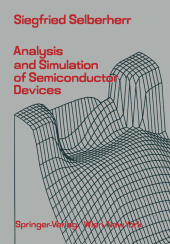 Neuerscheinungen 2011Stand: 2020-01-07 |
Schnellsuche
ISBN/Stichwort/Autor
|
Herderstra▀e 10
10625 Berlin
Tel.: 030 315 714 16
Fax 030 315 714 14
info@buchspektrum.de |

S. Selberherr
Analysis and Simulation of Semiconductor Devices
Softcover reprint of the original 1st ed. 1984. 2011. xiv, 296 S. XIV, 294 pp. 126 figs. 244 mm
Verlag/Jahr: SPRINGER, WIEN; SPRINGER, BERLIN 2011
ISBN: 3-7091-8754-0 (3709187540)
Neue ISBN: 978-3-7091-8754-8 (9783709187548)
Preis und Lieferzeit: Bitte klicken
The invention of semiconductor devices is a fairly recent one, considering classical time scales in human life. The bipolar transistor was announced in 1947, and the MOS transistor, in a practically usable manner, was demonstrated in 1960. From these beginnings the semiconductor device field has grown rapidly. The first integrated circuits, which contained just a few devices, became commercially available in the early 1960s. Immediately thereafter an evolution has taken place so that today, less than 25 years later, the manufacture of integrated circuits with over 400.000 devices per single chip is possible. Coincident with the growth in semiconductor device development, the literature concerning semiconductor device and technology issues has literally exploded. In the last decade about 50.000 papers have been published on these subjects. The advent of so called Very-Large-Scale-Integration (VLSI) has certainly revealed the need for a better understanding of basic device behavior. The miniaturization of the single transistor, which is the major prerequisite for VLSI, nearly led to a breakdown of the classical models of semiconductor devices.
1. Introduction.- 1.1 The Goal of Modeling.- 1.2 The History of Numerical Device Modeling.- 1.3 References.- 2. Some Fundamental Properties.- 2.1 Poisson┤s Equation.- 2.2 Continuity Equations.- 2.3 Carrier Transport Equations.- 2.4 Carrier Concentrations.- 2.5 Heat Flow Equation.- 2.6 The Basic Semiconductor Equations.- 2.7 References.- 3. Proeess Modeling.- 3.1 Ion Implantation.- 3.2 Diffusion.- 3.3 Oxidation.- 3.4 References.- 4. The Physical Parameters.- 4.1 Carrier Mobility Modeling.- 4.2 Carrier Generation-Recombination Modeling.- 4.3 Thermal Conductivity Modeling.- 4.4 Thermal Generation Modeling.- 4.5 References.- 5. Analytical Investigations About the Basic Semiconductor Equations.- 5.1 Domain and Boundary Conditions.- 5.2 Dependent Variables.- 5.3 The Existence of Solutions.- 5.4 Uniqueness or Non-Uniqueness of Solutions.- 5.5 Sealing.- 5.6 The Singular Perturbation Approach.- 5.7 Referenees.- 6. The Diseretization of the Basic Semiconductor Equations.- 6.1 Finite Differences.- 6.2 Finite Boxes.- 6.3 Finite Elements.- 6.4 The Transient Problem.- 6.5 Designing a Mesh.- 6.6 Referenees.- 7. The Solution of Systems of Nonlinear Algebraic Equations.- 7.1 Newton┤s Method and Extensions.- 7.2 Iterative Methods.- 7.3 Referenees.- 8. The Solution of Sparse Systems of Linear Equations.- 8.1 Direct Methods.- 8.2 Ordering Methods.- 8.3 Relaxation Methods.- 8.4 Alternating Direction Methods.- 8.5 Strongly Implicit Methods.- 8.6 Convergence Acceleration of Iterative Methods.- 8.7 Referenees.- 9. A Glimpse on Results.- 9.1 Breakdown Phenomena in MOSFET┤s.- 9.2 The Rate Effect in Thyristors.- 9.3 Referenees.- Author Index.- Table Index.


